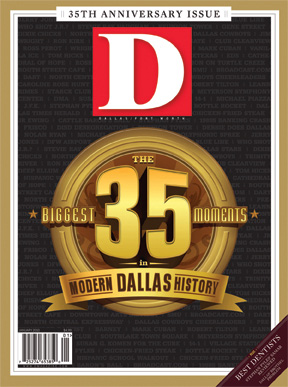They proposed the concept of 14-1, wherein the city elects the mayor, but the 14 councilmembers are from single-member districts. On November 5, 1991, four blacks and two Hispanics were elected to the City Council. But the fight over the system is not over. It continues today as some claim it leads to corruption (i.e., the recent conviction of Don Hill), while others say it has paved roads and built schools. Regardless of what’s being argued, 14-1 is the reason so many voices are being heard.
Almost 20 years ago, in 1990, all political power in Dallas rested with a small political elite, which pretty much ran the city. At the time it was an almost-all-white group with only a few safe minority members. That summer we fought for an election to create 14 City Council districts, with only the mayor elected at large, but it was defeated with a vote along racial lines. Our attempts to work a deal with Mayor Annette Strauss and councilmembers were frustrating, since little headway could be made.
I recall a meeting at a church in South Dallas, when we decided that the only option left was to start a campaign of civil disobedience. As a lawyer, the idea of wearing chains at a City Hall protest was not my idea of fun. However, with the city polarized and a majority of the council dug in to keep the status quo, we had little choice. That is how we made Time magazine for the first time, with a picture of me, Steve Salazar, and Roberto Alonzo (all future elected officials) in symbolic political chains. A Dallas political struggle became national news.
Soon after, I got the call from a law clerk in federal Judge Jerry Buchmeyer’s court advising us that he was striking down the 8-3 system. We called all the people who had struggled for so long—Henry Martinez (a World War II veteran who was the lead Latino plaintiff), Marvin Crenshaw, Roy Williams, and dozens of community leaders—and went to El Ranchito Restaurant in the heart of North Oak Cliff to celebrate. The feelings were close to the joy of seeing my sons’ births. Actually it was almost the same as seeing a birth, but one of real democracy.
The next day I got a call from Charles Tandy, who represented North Oak Cliff. He wanted to maintain a majority Anglo seat in Oak Cliff and agreed to support our plan for 14-1 if we could work it out. His vote was key to getting a majority of the City Council to accept the judge’s ruling and not proceed with a long appeal.
We arranged a meeting in my law office, attended by councilmembers Diane Ragsdale, Al Lipscomb, Jim Burger, and Tandy. Working with all of our experts until 4 am, we drew the Latino and African-American districts, plus the majority Anglo Oak Cliff district. Joe May, who went on to become a Dallas ISD trustee, looked me in the eyes and said, “We just changed the future of Dallas history.” A sense of awe and heavy responsibility hit me all at once. I thought of the residents of the Ledbetter neighborhood in far West Dallas, who still had few paved streets and, of course, no curbs or gutters. Could we change their lives? I thought of how the neighborhood I grew up in, once called Little Mexico, had been destroyed with little thought to the community who had lived there for decades. They had no voice at City Hall.
After I was elected as one of the first Latino councilmembers under 14-1, I realized the Dallas I grew up in—the one where policemen routinely abused your friends, the one where you expected little or no city services, the one where you were turned away because of the color of your skin—was gone.
Though 14-1 has had its pros and cons, compared to the Dallas of 1990, it has helped to improve the lives of hundreds of thousands of people. Sometimes a few determined people can make a difference. In 1991, they did.
Domingo Garcia, a former Dallas City Council member and state representative, is an attorney in private practice.






